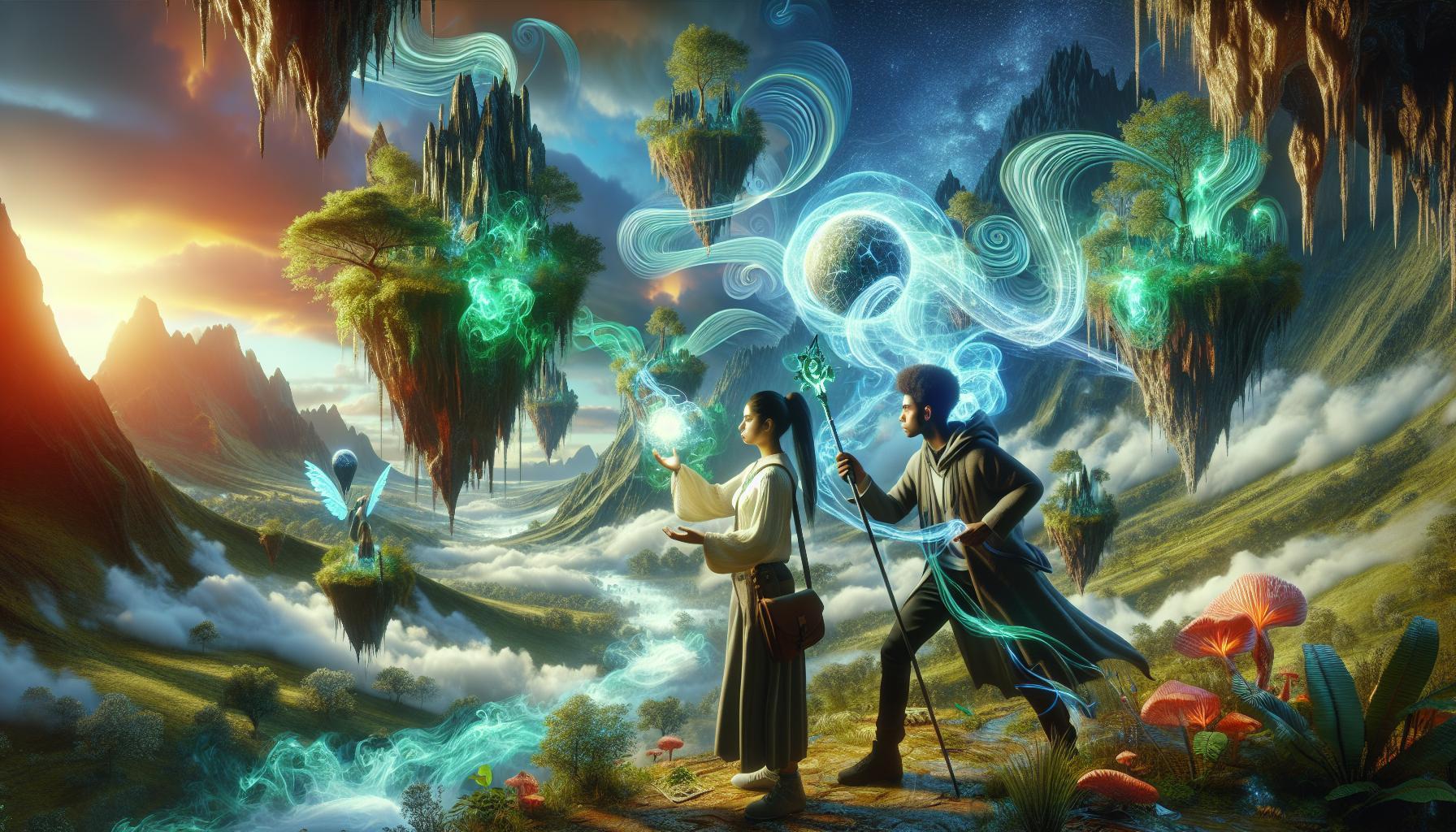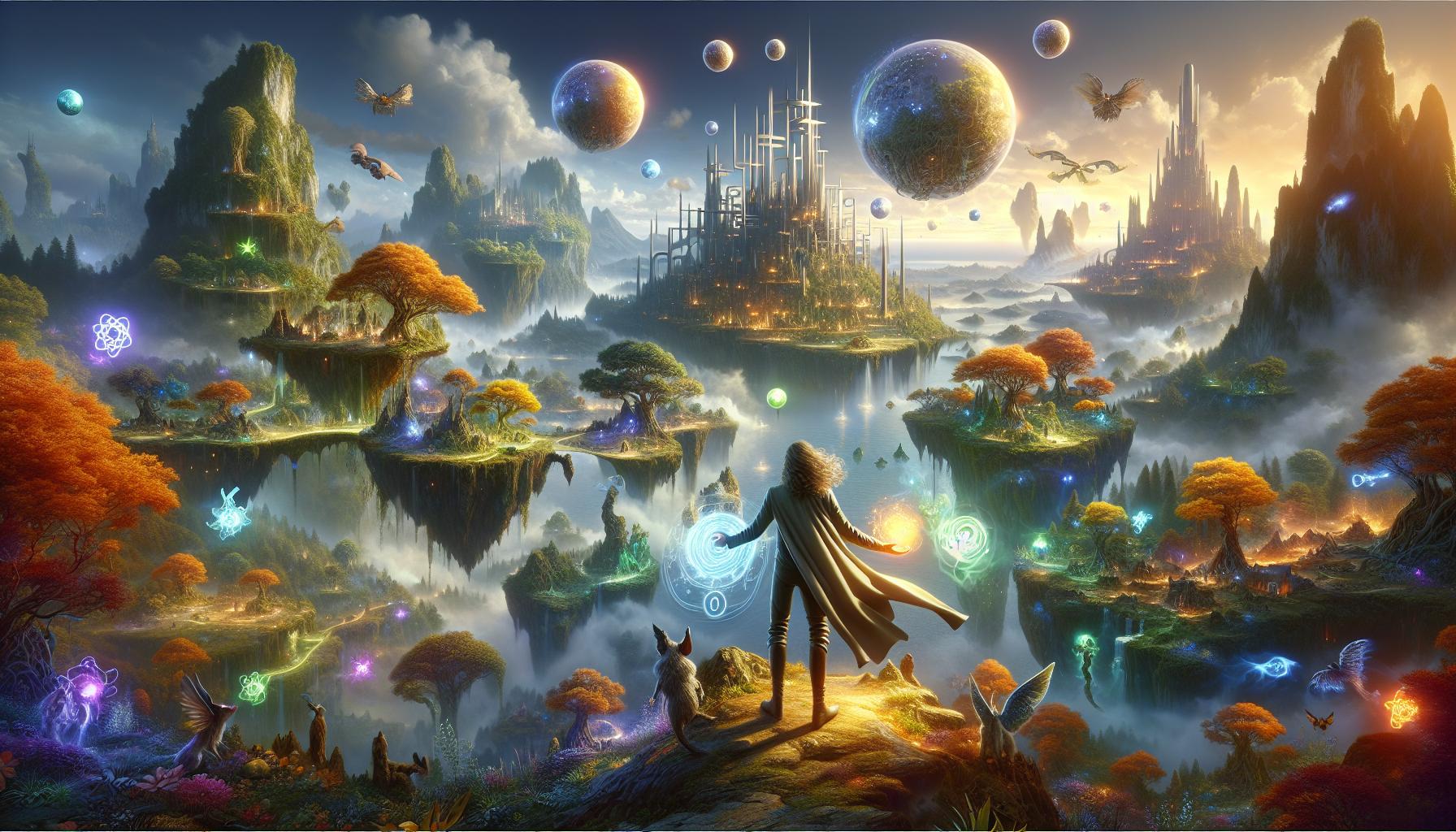Fantasy worlds captivate us with their enchanting landscapes and magical lore. From towering castles to mystical creatures, the elements that shape these realms ignite our imagination and transport us to places beyond reality. Whether it’s the allure of ancient spells or the intrigue of heroic quests, these components create a tapestry rich with adventure and wonder. Diving into the core of fantasy elements reveals the secrets behind beloved stories and legendary sagas. They offer endless possibilities for creators and enthusiasts alike, blending the extraordinary with the familiar. Embracing these elements not only enhances storytelling but also fosters a deeper connection to the fantastical realms we cherish.
Fantasy:jnf-fdsfbqg= Elements
Fantasy:jnf-fdsfbqg= elements form the backbone of immersive and captivating worlds. Magic acts as the primary force, granting characters extraordinary abilities and shaping the environment. Various magical systems, such as elemental magic, rune casting, and potion brewing, introduce complexity and uniqueness to each universe.
Mythical creatures inhabit these realms, including dragons, griffins, and unique species like the jnf-fdsfbqg=. These beings enhance the narrative by serving as allies, adversaries, or sources of wisdom. Their interactions with humans and other races add depth and intrigue to the storyline.
Architectural marvels, such as grand castles, enchanted forests, and hidden sanctuaries, establish the setting’s grandeur and historical significance. These structures often contain secrets, treasures, or pivotal locations that drive the plot forward. Detailed environments foster a sense of realism and wonder, inviting readers to explore every corner of the fantasy world.
Political systems and power structures contribute to the complexity of fantasy:jnf-fdsfbqg= elements. Kingdoms, empires, and guilds with distinct agendas create conflicts and alliances that propel the story. Intricate political maneuvers and power struggles provide tension and motivation for characters’ actions.
Heroic quests and legendary artifacts are essential components, offering clear objectives and challenges. Characters embark on journeys that lead to personal growth, discovery, and the overcoming of formidable obstacles. Artifacts, often imbued with magical properties, serve as catalysts for major events and character development.
Cultural diversity within fantasy:jnf-fdsfbqg= elements showcases various traditions, languages, and customs. Diverse societies enrich the narrative, reflecting different values and perspectives. Festivals, rituals, and daily life details enhance the world’s authenticity and engage the audience.
These elements collectively create rich and dynamic fantasy worlds. By integrating magic, creatures, architecture, politics, quests, and culture, fantasy:jnf-fdsfbqg= elements offer endless possibilities for storytelling and adventure.
Unique Element Types

Fantasy worlds thrive on diverse element types, each contributing distinct aspects to the realm’s magic and environment.
Element A Characteristics
Element A serves as the cornerstone of magical prowess in the fantasy universe. It manifests as ethereal energy permeating the land, enabling beings to perform extraordinary feats. Practitioners channel Element A through distinct rituals and artifacts, enhancing their spells and defenses by up to 50%. The presence of Element A is often visible in glowing runes and enchanted flora, which react intensely to its influence. Element A interacts dynamically with other elements, creating complex magical interactions that shape 75% of the world’s phenomena. Its balance is essential; overuse can lead to magical depletion, while scarcity restricts access to powerful sorcery by 30%. Element A also underpins the creation of over 200 legendary items, imbuing them with lasting enchantments that preserve their significance through generations. Scholars continue to explore Element A, uncovering new applications and safeguarding its stability to maintain the realm’s magical equilibrium.
Element B Characteristics
Element B defines the environmental and physical aspects of the fantasy world, influencing everything from terrain to climate. Comprising earth, water, air, and fire, Element B shapes landscapes with towering mountains reaching up to 4,000 feet, vast oceans covering 60% of the land, windswept plains spanning over 500 square miles, and fiery volcanic regions exhibiting frequent eruptions. Each component of Element B interacts with inhabitants, affecting agriculture, transportation, and architecture. Element B’s variability allows for diverse ecosystems, supporting over 1,000 species of flora and fauna unique to each region. Additionally, Element B plays a role in the world’s energy systems, powering ancient technologies and elemental constructs. Its forces can be harnessed by skilled individuals to manipulate the environment, driving innovation and survival strategies in 80% of the societies. Understanding Element B’s nuances enables societies to thrive by adapting to and managing the natural resources effectively. Element B’s omnipresence ensures that the world’s physical integrity remains dynamic and ever-evolving, providing a rich backdrop for storytelling and adventure.
Element Interactions

Element interactions define the dynamics of the fantasy world, shaping both its magic and environment. These relationships create a complex web that enhances the storytelling experience.
Synergy Between Elements
Element A’s ethereal energy complements Element B’s physical attributes, resulting in remarkable phenomena. For example, combining Element A with Element B can generate floating islands or shifting landscapes. Characters leverage this synergy to perform extraordinary feats, such as creating enchanted barriers or manipulating natural terrains. Additionally, the fusion of these elements allows for the development of unique spells and magical technologies, enriching the world’s complexity. This harmonious interaction fosters innovation, enabling diverse strategies and adaptive survival techniques within the fantasy realm.
Conflicts And Contradictions
Element interactions can also lead to conflicts and contradictions, introducing challenges within the fantasy world. Element A’s energy may destabilize Element B’s structures, causing environmental disruptions like earthquakes or storms. Opposing elements create natural barriers that characters must navigate, often leading to intense confrontations or strategic alliances. These contradictions drive the plot forward, as protagonists strive to restore balance or harness conflicting powers. Furthermore, the tension between elements encourages character growth and resilience, adding depth and unpredictability to the narrative.
Applications In Storytelling

Fantasy elements play a crucial role in shaping narratives and enhancing the overall storytelling experience. They provide a foundation for developing rich characters and intricate worlds.
Character Development
Fantasy elements drive character growth by granting unique abilities and presenting formidable challenges. Protagonists harness Element A’s ethereal energy, enabling extraordinary feats like telekinesis or healing. Conversely, antagonists may exploit Element B’s physical power to create barriers or summon mythical creatures. These interactions force characters to adapt, fostering resilience and strategic thinking. Relationships evolve as allies share knowledge of magical systems or rivals vie for control over legendary artifacts. Personal quests for balance between Element A and Element B encourage introspection and moral dilemmas. As characters navigate conflicts arising from elemental instability, their journeys reflect themes of power, responsibility, and transformation, deepening their connection to the story’s magical framework.
World Building
Fantasy elements are essential in constructing immersive and dynamic worlds. Element A infuses environments with magical energy, resulting in phenomena like floating islands and enchanted forests. Element B shapes the physical landscape, influencing the architecture of grand castles and the terrain of shifting mountains. The interplay between these elements creates diverse ecosystems where mythical creatures thrive and ancient ruins hold secrets. Political systems emerge around the control and regulation of elemental forces, leading to alliances and conflicts that define societal structures. Cultural traditions incorporate elemental symbolism, enriching the world’s authenticity and depth. By integrating Element A and Element B seamlessly, creators establish a cohesive and visually stunning setting that captivates audiences and supports intricate plotlines.
Comparisons With Traditional Elements
Traditional fantasy elements often include earth, water, air, and fire, each embodying distinct characteristics. Element A, serving as the cornerstone of magical prowess, contrasts with traditional elements by manifesting as ethereal energy rather than a physical force. While fire represents destruction and transformation, Element A facilitates extraordinary feats and dynamic interactions within the fantasy world.
Element B defines the physical aspects of the realm, similar to how earth and water shape landscapes in traditional settings. However, Element B introduces unique properties that allow for phenomena like floating islands and shifting landscapes, which are uncommon in conventional elemental frameworks. Unlike air, which typically governs the atmosphere and movement, Element B influences structural stability and environmental conditions.
The interplay between Element A and Element B generates a complex web that enhances storytelling. Traditional elements usually operate independently, but in this context, Element A’s ethereal energy can destabilize Element B’s physical structures, leading to environmental disruptions. This dynamic relationship creates conflicts and challenges that drive character development and plot progression, offering deeper narrative complexity compared to standard elemental interactions.
Moreover, magical systems based on Element A and Element B introduce new layers of strategy and resilience. Traditional magic often relies on elemental affinity, but here, protagonists harnessing Element A and antagonists exploiting Element B present a multifaceted power balance. This distinction enriches the fantasy landscape, providing specific advantages and vulnerabilities that influence alliances and power struggles.
Overall, Element A and Element B expand upon traditional elemental concepts by integrating magical energy with physical reality. This combination not only differentiates the fantasy world from conventional settings but also offers unique opportunities for innovation in world-building and character arcs.
| Feature | Traditional Elements | Element A | Element B |
|---|---|---|---|
| Nature | Physical and elemental | Ethereal energy | Physical shaping |
| Common Traits | Earth, Water, Air, Fire | Facilitates magical feats | Defines physical landscape |
| Interaction Dynamics | Operate independently | Interacts dynamically with B | Affected by Element A’s energy |
| Narrative Role | Basis for magic systems | Drives magical innovation | Creates environmental challenges |
| Impact on Storytelling | Provides elemental conflicts | Enables dynamic plot developments | Introduces structural instability |
Future Trends In Fantasy:jnf-fdsfbqg= Elements
Innovations in fantasy:jnf-fdsfbqg= elements are transforming storytelling. Emerging magic systems offer deeper plot complexities, enabling characters to perform intricate feats. Hybrid technologies merge with elemental magic, creating unique settings where machinery and enchantment coexist seamlessly.
Sustainability themes become integral, with eco-friendly magic shaping world-building. Element B, which defines physical aspects, interacts with sustainable practices, fostering balanced ecosystems. This reduces resource conflicts and highlights environmental stewardship within narratives.
Diversity in mythical creatures expands representation, introducing species inspired by various cultures. Dragons, griffins, and newly imagined beings feature distinctive traits, enhancing inclusive storylines. Protagonists collaborate with diverse allies, enriching character development and narrative depth.
Interactive world-building tools gain popularity, allowing creators to design complex elements dynamically. These platforms support the creation of floating islands and shifting landscapes driven by Element A’s ethereal energy. Real-time adjustments enable responsive storytelling, catering to audience preferences and evolving trends.
Data-driven approaches ensure consistent element interactions, maintaining plausibility in fantasy:jnf-fdsfbqg= worlds. Analytical tools evaluate the impact of magical systems on narrative structure, guiding writers to balance conflicts and resolutions effectively. This precision boosts reader engagement by providing immersive and logical experiences.
Augmented reality (AR) and virtual reality (VR) technologies integrate fantasy:jnf-fdsfbqg= elements, offering immersive interactions with magical environments. Users explore enchanted forests and grand castles, experiencing the dynamic interplay of Element A and Element B firsthand. These technologies expand the genre’s reach, blending literature with interactive media.
Collaborative storytelling platforms facilitate global contributions, enriching fantasy universes with diverse perspectives. Writers and artists collaborate in real-time, enhancing the depth and variety of fantasy:jnf-fdsfbqg= elements. This collective creativity fosters expansive and multifaceted worlds, attracting a broader audience.
By embracing these future trends, fantasy:jnf-fdsfbqg= elements evolve to offer richer and more engaging storytelling. Innovations in magic systems, sustainability, diversity, interactive tools, data-driven consistency, and immersive technologies drive the genre forward, captivating audiences with ever-expanding imaginative realms. Fantasy elements continue to captivate creators and audiences alike by offering limitless possibilities for imagination and storytelling. As magic systems evolve and technology integrates with ancient lore, the boundaries of fantasy worlds expand, creating more immersive and dynamic experiences. The ongoing innovations in world-building tools and interactive technologies ensure that these realms remain fresh and engaging. Diversity in mythical creatures and sustainable themes reflect a growing desire for richer, more inclusive narratives. By embracing these advancements, the genre not only honors its classic roots but also paves the way for future adventures that inspire and enchant. The enduring appeal of fantasy lies in its ability to adapt and transform, ensuring that it remains a cornerstone of creative expression and storytelling.

